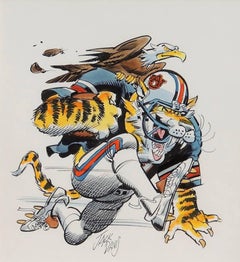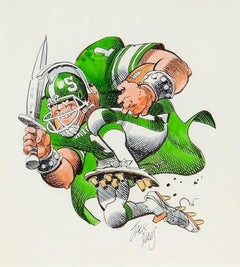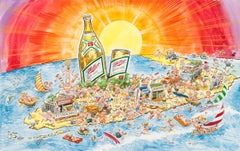Jack Davis Drawings and Watercolor Paintings
Color: Beige
Artist: Jack Davis
Political Parody
By Jack Davis
Located in Fort Washington, PA
Medium: Watercolor on Paper
Signature: Signed Lower Right
Category
Early 2000s Jack Davis Drawings and Watercolor Paintings
Materials
Watercolor, Paper
Buffalo Bills Football Illustration
By Jack Davis
Located in Fort Washington, PA
Medium: Ink and Watercolor on Bristol Board
Dimensions: 10.00" x 9.50"
Signature: Unsigned
This illustration was used for licensed apparel.
Category
Late 20th Century Jack Davis Drawings and Watercolor Paintings
Materials
Watercolor, Board, Ink
Oklahoma Sooners
By Jack Davis
Located in Fort Washington, PA
Date: 1990
Medium: Mixed Media over Graphite on Paper affixed Illustration Board
Dimensions: 8.50" x 11.50"
Signature: Signed Lower Right
Jack Davis Oklahoma Sooners College Football...
Category
1990s Jack Davis Drawings and Watercolor Paintings
Materials
Illustration Board, Mixed Media, Graphite
Auburn University Tigers Football Illustration; Original Art
By Jack Davis
Located in Fort Washington, PA
Medium: Ink and Watercolor on Board
Dimensions: 8.75" x 9.5"
Signature: Signed Lower Center
Davis, a Southerner himself, manages to work in both the Tigers nickname and a reference to the "War...
Category
Mid-20th Century Jack Davis Drawings and Watercolor Paintings
Materials
Watercolor, Ink, Board
Michigan State Spartans Football Illustration
By Jack Davis
Located in Fort Washington, PA
Dimensions: 9.00" x 8.50"
Signature: Signed Lower Right
They just made the Final Four in basketball and barely missed the playoff in football too -- State is hot right now. Here'...
Category
Late 20th Century Jack Davis Drawings and Watercolor Paintings
Materials
Paint
Related Items
The Abduction of the Sabine Women , a Renaissance drawing by Biagio Pupini
Located in PARIS, FR
This vigorous drawing has long been attributed to Polidoro da Caravaggio: The Abduction of the Sabine Women is one of the scenes that Polidoro depicted between 1525 and 1527 on the façade of the Milesi Palazzo in Rome. However, the proximity to another drawing inspired by this same façade, kept at the Ecole des Beaux-Arts, and to other drawings inspired by Polidoro kept at the Musée du Louvre, leads us to propose an attribution to Biagio Pupini, a Bolognese artist whose life remains barely known, despite the abundant number of drawings attributed to him.
1. Biagio Pupini, a Bolognese artist in the light of the Roman Renaissance
The early life of Biagio Pupini, an important figure of the first half of the Cinquecento in Bologna - Vasari mentions him several times - is still poorly known. Neither his date of birth (probably around 1490-1495) nor his training are known. He is said to have been a pupil of Francesco Francia (1450 - 1517) and his name appears for the first time in 1511 in a contract with the painter Bagnacavallo (c. 1484 - 1542) for the frescoes of a church in Faenza. He then collaborated with Girolamo da Carpi, at San Michele in Bosco and at the villa of Belriguardo.
He must have gone to Rome for the first time with Bagnacavallo between 1511 and 1519. There he discovered the art of Raphael, with whom he might have worked, and that of Polidoro da Caravaggio. This first visit, and those that followed, were the occasion for an intense study of ancient and modern art, as illustrated by his abundant graphic production.
Polidoro da Caravaggio had a particular influence on the technique adopted by Pupini. Executed on coloured paper, his drawings generally combine pen, brown ink and wash with abundant highlights of white gouache, as in the drawing presented here.
2. The Abduction of the Sabine Women
Our drawing is an adaptation of a fresco painted between 1525 and 1527 by Polidoro da Caravaggio on the façade of the Milesi Palace in Rome. These painted façades were very famous from the moment they were painted and inspired many artists during their stay in Rome. These frescoes are now very deteriorated and difficult to see, as the palace is in a rather narrow street.
The episode of the abduction of the Sabine women (which appears in the centre of the photo above) is a historical theme that goes back to the origins of Rome and is recounted both by Titus Livius (Ab Urbe condita I,13), by Ovid (Fasti III, 199-228) and by Plutarch (II, Romulus 14-19). After killing his twin brother Romus, Romulus populates the city of Rome by opening it up to refugees and brigands and finds himself with an excess of men. Because of their reputation, none of the inhabitants of the neighbouring cities want to give them their daughters in marriage. The Romans then decide to invite their Sabine neighbours to a great feast during which they slaughter the Sabines and kidnap their daughters.
The engraving made by Giovanni Battista Gallestruzzi (1618 - 1677) around 1656-1658 gives us a good understanding of the Polidoro fresco, allowing us to see how Biagio Pupini reworked the scene to extract this dynamic group.
With a remarkable economy of means, Biagio Pupini takes over the left-hand side of the fresco and depicts in a very dense space two main groups, each consisting of a Roman and a Sabine, completed by a group of three soldiers in the background (which seems to differ quite significantly from Polidoro's composition).
The balance of the drawing is based on a very strongly structured composition. The drawing is organised around a median vertical axis, which runs along both the elbow of the kidnapped Sabine on the left and the foot of her captor, and the two main diagonals, reinforced by four secondary diagonals. This diamond-shaped structure creates an extremely dynamic space, in which centripetal movements (the legs of the Sabine on the right, the arm of the soldier on the back at the top right) and centrifugal movements (the arm of the kidnapper on the left and the legs of the Sabine he is carrying away, the arm of the Sabine on the right) oppose each other, giving the drawing the appearance of a whirlpool around a central point of support situated slightly to the left of the navel of the kidnapper on the right.
3. Polidoro da Caravaggio, and the decorations of Roman palaces
Polidoro da Caravaggio was a paradoxical artist who entered Raphael's (1483 - 1520) workshop at a very young age, when he oversaw the Lodges in the Vatican. Most of his Roman work, which was the peak of his career, has disappeared, as he specialised in facade painting, and yet these paintings, which are eminently visible in urban spaces, have influenced generations of artists who copied them abundantly during their visits to Rome.
Polidoro Caldara was born in Caravaggio around 1495-1500 (the birthplace of Michelangelo Merisi, known as Caravaggio, who was born there in 1571), some forty kilometres east of Milan. According to Vasari, he arrived as a mason on the Vatican's construction site and joined Raphael's workshop around 1517 (at the age of eighteen according to Vasari). This integration would have allowed Polidoro to work not only on the frescoes of the Lodges, but also on some of the frescoes of the Chambers, as well as on the flat of Cardinal Bibiena in the Vatican.
After Raphael's death in 1520, Polidoro worked first with Perin del Vaga before joining forces with Maturino of Florence (1490 - 1528), whom he had also known in Raphael's workshop. Together they specialised in the painting of palace façades. They were to produce some forty façades decorated with grisaille paintings imitating antique bas-reliefs.
The Sack of Rome in 1527, during which his friend Maturino was killed, led Polidoro to flee first to Naples (where he had already stayed in 1523), then to Messina. It was while he was preparing his return to the peninsula that he was murdered by one of his assistants, Tonno Calabrese, in 1543.
In his Vite, Vasari celebrated Polidoro as the greatest façade decorator of his time, noting that "there is no flat, palace, garden or villa in Rome that does not contain a work by Polidoro". Polidoro's facade decorations, most of which have disappeared as they were displayed in the open air, constitute the most important lost chapter of Roman art of the Cinquecento. The few surviving drawings of the painter can, however, give an idea of the original appearance of his murals and show that he was an artist of remarkable and highly original genius.
4. The façade of the Milesi Palace
Giovanni Antonio Milesi, who commissioned this palace, located not far from the Tiber, north of Piazza Navona, was a native of the Bergamo area, like Polidoro, with whom he maintained close friendly ties. Executed in the last years before the Sack of Rome, around 1526-1527, the decoration of Palazzo Milesi is considered Polidoro's greatest decorative success.
An engraving by Ernesto Maccari made at the end of the nineteenth century allows us to understand the general balance of this façade, which was still well preserved at the time. The frescoes were not entirely monochrome, but alternated elements in chiaroscuro simulating marble bas-reliefs and those in ochre simulating bronze and gold vases...
Category
16th Century Old Masters Jack Davis Drawings and Watercolor Paintings
Materials
Ink, Gouache, Pen
Liber Mystia XLIII
By Henry Hablak
Located in Philadelphia, PA
"Liber Mystia XLIII" is an original artwork by Henry Hablak made of gouache, ink, and colored pencil on paper measuring 16.25"h x 12.25"w framed and 14"h x 11"w unframed.
Henry Habl...
Category
2010s Contemporary Jack Davis Drawings and Watercolor Paintings
Materials
Ink, Paper, Gouache, Color Pencil
Gustav Melcher ( German, 1898 -?) Boats off Venice Italy Ink Water Color c. 1918
By Gustav Melcher
Located in Meinisberg, CH
Gustav Melcher
(German, 1898-?)
Segelschiffe vor Venedig - Sailing ships off Venice
• India ink, water colour wash
• Visible image ca. 11.5 x 18 cm
• Glased Frame ca. 20 x 25 cm
• Verso various inscriptions
• Signed lower right
Gustav Melcher was a German painter and a pioneer in film, film criticism and film theory and created this clever little picture of the skyline of Venice with various vessels.
Going by the various inscriptions an the backing paper, this drawing was made in 1918 when Gustav was twenty years old and passed on three years later to Gertrud Melcher on the 1. 2. 1921. I have no reasons to doubt this information. The small drawing is still in its unopened frame, so maybe there is more information to be discovered , however this will be the privilege of the next owner.
The picture also has retained its original antique frame – note that it has lost over the years various sections of the gesso decoration.
The very precisely executed drawing is most enjoyable to look at and doing so, remember you are looking through the eyes of a young man, who saw this foreign sea cape over a century ago.
Thank you for your interest and please note, that I offer free worldwide shipping on all my items.
Gustav Melcher began his studies at the Düsseldorfer Kunstakademie under Peter Janssen and Eduard von Gebhardt. Originaly he was interested in figurative and portrait painting, but after time he decided to pursue the depiction of land- and marinescapes. Durin his studies the young artist undertook trips to visit England, Scotland, Belgium and France and he joined the artist society Malkasten. It was in those days he would hold speeches to his colleges about this new invention called ‘Kintopp’ – Melcher was a great advocate of the moving pictures...
Category
1910s Naturalistic Jack Davis Drawings and Watercolor Paintings
Materials
India Ink, Paper, Watercolor
Gustav MelcherGustav Melcher ( German, 1898 -?) Boats off Venice Italy Ink Water Color c. 1918, 1918
Free Shipping
H 7.88 in W 9.85 in D 0.79 in
'Navajo Family', Santa Fe, Modernism, Corcoran, Whitney, PAFA, AIC, WPA
By Eduard Buk Ulreich
Located in Santa Cruz, CA
Signed lower center, 'by Buk' for Eduard Buk Ulreich (American, 1889-1966), dedicated lower center, 'for Ruth' and painted circa 1945. Additionally signed and titled verso 'Navajo Fa...
Category
1940s Art Deco Jack Davis Drawings and Watercolor Paintings
Materials
Gouache, Illustration Board, Watercolor
Fawn
By Henry Hablak
Located in Philadelphia, PA
"Fawn" is an original ink, colored pencil, and gouache on paper artwork by Henry Hablak measuring 30"h x 22"w.
Henry Hablak is a tattoo artist and illustrator based out of Philadel...
Category
2010s Contemporary Jack Davis Drawings and Watercolor Paintings
Materials
Ink, Color Pencil, Gouache, Paper
Richard Caton Woodville II (1856 - 1927) 1794 War Balloon Aquarell England 1910
By Richard Caton Woodville Jr.
Located in Meinisberg, CH
Richard Caton Woodville II
(British, 1856 - 1927)
The French Aerostatic Corps - The first War Balloon The launching of the L'Entreprenant used by the French Army under General Jourd...
Category
1910s English School Jack Davis Drawings and Watercolor Paintings
Materials
Paper, Watercolor, Gouache, Cardboard
Free Shipping
H 15.56 in W 22.25 in D 1.58 in
The Star Press - Drawing by Suzanne Tourte - 1950s
Located in Roma, IT
The star press is an artwork realized by Suzanne Tourte, in 1950s.
Original watercolor.
33 x 25 cm.
Good conditions, except for some yellowing on pa...
Category
1950s Modern Jack Davis Drawings and Watercolor Paintings
Materials
Paper, Watercolor
Nightie Night - 5"x9", Small Framed Artwork, White, Beige, Feminine
By Andrea Stajan-Ferkul
Located in Mississauga, Ontario
A soft neutral palette used in this artwork adds to the graceful, feminine quality of the subject matter. Focus is placed on the blending of delicate detail and expressive brush wor...
Category
2010s Contemporary Jack Davis Drawings and Watercolor Paintings
Materials
Acrylic, Pencil, Illustration Board
H 13 in W 23 in D 2.5 in
WPA Post Office Mural Study Native American Scene Regionalism Social Realism
By Louise Ronnebeck
Located in New York, NY
WPA Post Office Mural Study Native American Scene Regionalism Social Realism
Louise Emerson Ronnebeck (1901 - 1980)
Proposal Sketch for Worland Wyoming Post Office WPA Mural Project
Image: 7 x 15 inches
Board 14 x 22 inches
Watercolor on paper, attached to black/gray cardboard/thick paper
c. 1937
Signed lower right
Written in Louise's hand on mounting paper in white chalk/pencil: "Sketch for Mural...
Category
1930s American Realist Jack Davis Drawings and Watercolor Paintings
Materials
Paper, Cardboard, Watercolor
Surrealist Painting on Paper, 'Godot', Artefacts of Civilisations Lost
Located in Cotignac, FR
A late 20th century watercolour, gouache and acrylic on paper by British artist Derek Carruthers. Signed to the bottom right and dated 1985 and titled, 'Godot' to the reverse.
A ch...
Category
Late 20th Century Surrealist Jack Davis Drawings and Watercolor Paintings
Materials
Acrylic, Gouache, Watercolor, Paper
No Reserve
H 19.69 in W 27.56 in D 0.08 in
Mid Century Horse in Winter Landscape
By William Ernest Smyth
Located in Soquel, CA
Charming mid century watercolor painting of a horse in winter with a barn in the background by Ernest Smythe (American/England 1881-1950). Signed "ERNEST SMYTHE" in lower left corner. Presented in a tan mat with a wood frame and glass. Image size: 25"H x 19.75"W
As William Ernest Smyth, he was born at 13 Commercial Road, Ipswich on 9 April 1874 but was not baptised at St Michael's, Ipswich until 23 October 1885, when his birth date is given as 17 February 1874, youngest son of artist Thomas Smythe...
Category
Mid-20th Century Realist Jack Davis Drawings and Watercolor Paintings
Materials
Watercolor, Illustration Board
Place de la Concorde by Jean Dufy - Mixed media on paper, Parisian scene
By Jean Dufy
Located in London, GB
*UK BUYERS WILL PAY AN ADDITIONAL 5% IMPORT DUTY ON TOP OF THE ABOVE PRICE
Place de la Concorde by Jean Dufy (1888-1964)
Gouache and watercolour on paper
48.6 x 63.2 cm (19 ¹/₈ x 24 ⁷/₈ inches)
Signed lower right, Jean Dufy
Executed circa 1955
This work is accompagnied by a certificate of authenticity signed by Jacques Bailly and will be included in the forthcoming Catalogue Raisonné vol.3 currently being prepared by Jacques Bailly.
Provenance: Private collection, France
Artist biography:
Born into a large family in the busy port-city of La Havre in northern France, Jean Dufy was the younger brother of the Fauvist painter Raoul Dufy. In order to please his accountant father, Jean was...
Category
1950s Modern Jack Davis Drawings and Watercolor Paintings
Materials
Paper, Watercolor, Gouache
Previously Available Items
Miller High Life "Spring Break" Advertising Painting; Original Art
By Jack Davis
Located in Fort Washington, PA
Medium: Watercolor over Graphite
Dimensions: 27.00" x 17.00"
Signature: Signed Lower Right
Miller High Life "Spring Break" Advertising Painting...
Category
Late 20th Century Jack Davis Drawings and Watercolor Paintings
Materials
Watercolor, Board, Graphite
Basketball Superstars Comic Illustration; Original Art
By Jack Davis
Located in Fort Washington, PA
Date: 1980s
Medium: Ink and Watercolor over Graphite on Board
Dimensions: 15.50" x 18.00"
Signature: Signed Lower Right
Longtime MAD artist Davis il...
Category
1980s Jack Davis Drawings and Watercolor Paintings
Materials
Ink, Watercolor, Board, Graphite
Jack Davis drawings and watercolor paintings for sale on 1stDibs.
Find a wide variety of authentic Jack Davis drawings and watercolor paintings available for sale on 1stDibs. You can also browse by medium to find art by Jack Davis in board, ink, paint and more. Not every interior allows for large Jack Davis drawings and watercolor paintings, so small editions measuring 8 inches across are available. Customers who are interested in this artist might also find the work of Guillaume Azoulay, Patrick Lichty, and Andrea Moreau. Jack Davis drawings and watercolor paintings prices can differ depending upon medium, time period and other attributes. On 1stDibs, the price for these items starts at $1,900 and tops out at $4,800, while the average work can sell for $1,900.








